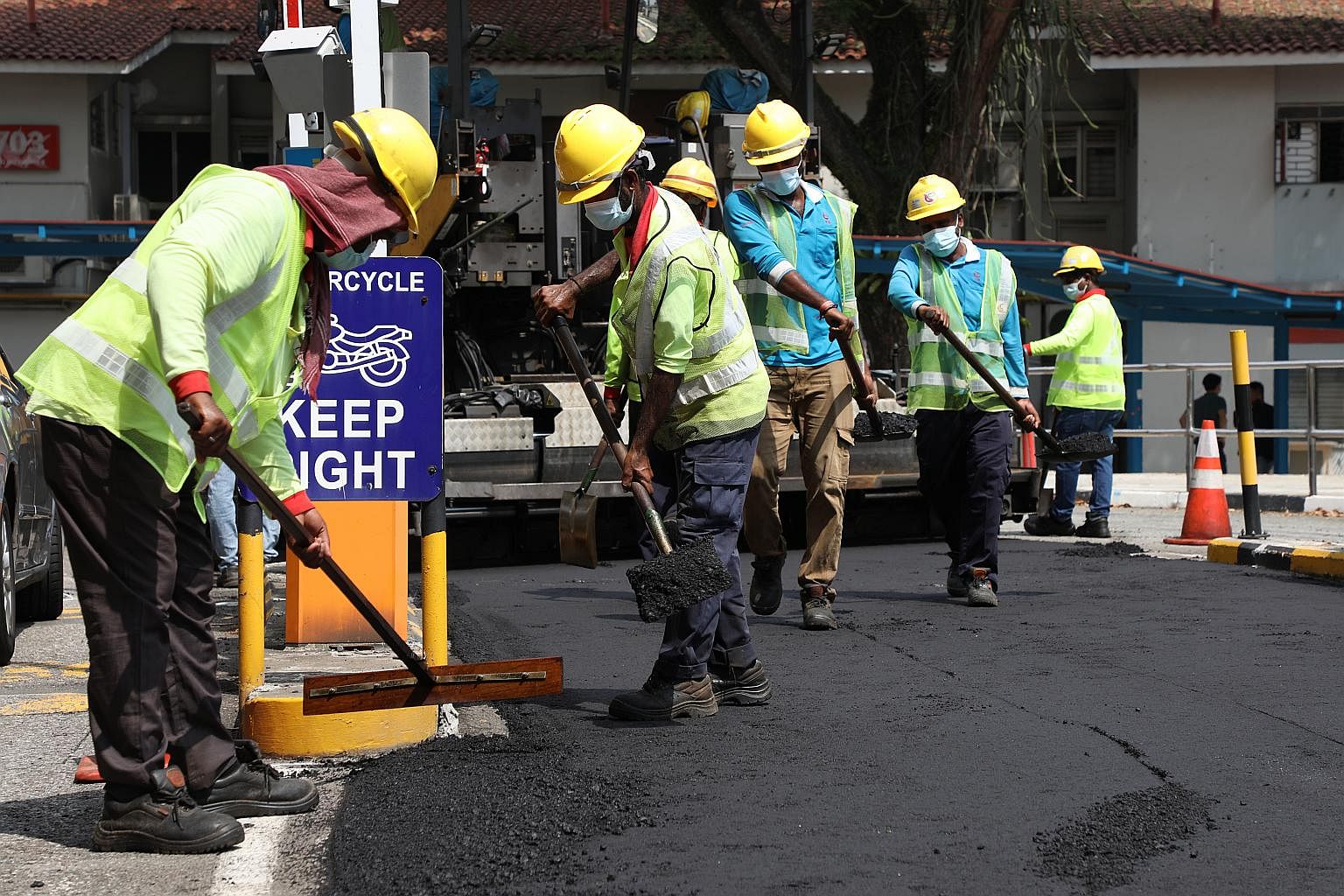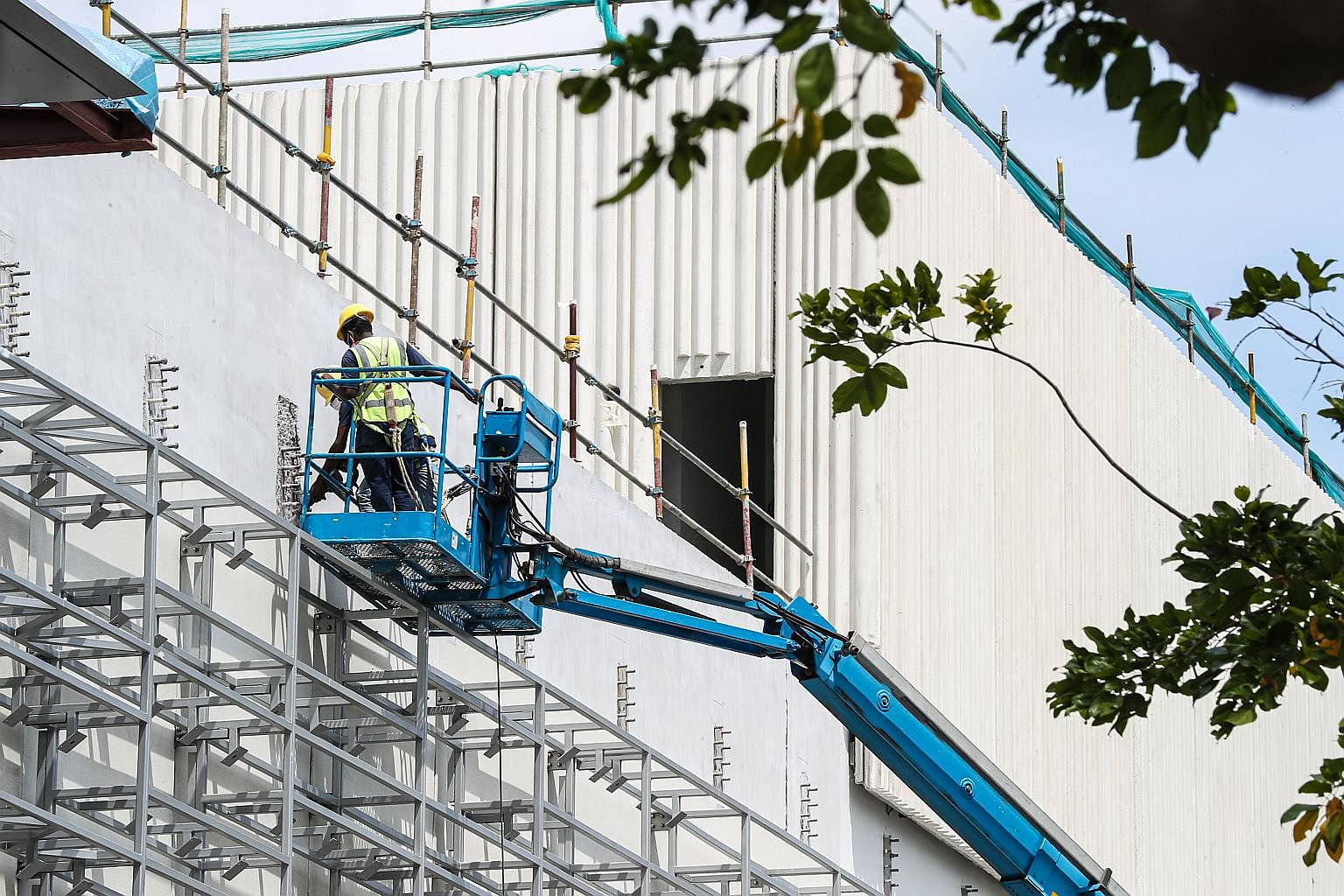NUS scientists to study construction workers' risk of heat stress
Sign up now: Get ST's newsletters delivered to your inbox

Forty employees' and migrant workers' core temperatures and thermal demands will be tracked as they work.
PHOTO: LIANHE ZAOBAO
Follow topic:
SINGAPORE - Scientists here will start a new study into how susceptible construction workers are to heat stress at their worksites and dormitories next month.
Forty employees' and migrant workers' core temperatures and thermal demands will be tracked as they work, allowing scientists to propose solutions to reduce and prevent workers' heat stress.
This will be especially pertinent as climate change is expected to bring in higher temperatures and possibly more heatwaves in future.
The study is part of Project HeatSafe, which was started in 2020 to find out how rising temperatures affect the health and work productivity of groups of people in South-east Asia. The research project is based in the National University of Singapore (NUS).
Rising temperatures are increasing the threat of heatwaves across Asia, and countries in the region will be hit with more punishing drought conditions by the end of this century, the United Nations' climate science body said in a new report last month.
Singapore's heat woes are compounded by the humidity and the urban heat island effect, where heat trapped by built-up areas in the day is released at night. This means the urban areas here are much warmer than the rural parts.

The new study's lead principal investigator, Associate Professor Jason Lee from NUS' Yong Loo Lin School of Medicine (NUS Medicine), said people at higher risk of heat-related complications in a changing climate include outdoor workers, people working or living in less-ventilated environments, and seniors with existing conditions such as cardiovascular disease.
While heat-induced death and exertional heatstroke are well-known dangers, other lesser-known heat-related risks in the construction and labour sectors are accidents and loss of productivity.
"Studies done overseas have shown that when you're hot or hyperthermic, you tend to make wrong or unsound decisions due to thermal discomfort. If a machine requires 10 steps to operate, but you feel hot and uncomfortable, you may skip some steps and that may result in accidents and injuries," said Prof Lee.
His multidisciplinary team includes economists, epidemiologists, sociologists, and physiologists - like Prof Lee.
For the new study, which starts next month, his team will closely monitor and track the workers' thermal demands over 24 hours using a range of tools - from studying their urine samples to assess their hydration status, to getting them to pop thermometer pills.
Resembling a medicine or vitamin capsule, a temperature-sensing pill will travel down a person's digestive tract and detect his deep body temperature, which refers to the temperature of the body's internal organs.
The pill will wirelessly transmit the temperature data to a handheld sensor, and be passed out after a couple of days.
This method is the gold standard to quantify heat strain, said Prof Lee, who is also the deputy director of the Human Potential Translational Research Programme at NUS Medicine.
The researchers will also hear from the workers to find out whether and how they feel affected by heat. They will also observe how the workers rest in their dorms.
"If they don't rest well, their overall thermal stress can be exacerbated. The start state at every work day is key," he added.
To assess fatigue, the researchers will also conduct physical assessments to measure and compare the workers' grip strength and balance before and after work.
In June and July, Prof Lee and his team will conduct similar fieldwork at a construction site in Cambodia and in an indoor factory in Vietnam as part of regional studies under Project HeatSafe.
The researchers will revisit the worksites in Singapore and the two countries at the end of the year, when the weather tends to be cooler, to compare the workers' thermal demands and productivity between both seasons.

With the findings, the team will propose cost-effective solutions for workers to beat the heat and reduce their risk of heat stress.
Possible solutions may include specific work-rest cycles and sheltered resting places with fans and good wind flow.
The Centre for Climate Research Singapore has previously projected that Singapore's maximum daily temperature could reach 35 to 37 deg C by 2100.
Local temperatures are about 1.8 deg C higher than they were in 1948. In comparison, global temperatures have warmed by about 1.1 deg C from pre-industrial times.
Prof Lee said one way people can "heat-proof" themselves is to do more aerobic fitness exercises to train the heart to pump blood more efficiently and raise their thermal tolerance.
However, he observed that Singapore is not quite in a favourable situation to manage increased heat.
"We are also becoming a more sedentary society, and we are an increasingly ageing society. Seniors would struggle to deal with heat as they cannot sweat as much."
Seniors with cardiovascular disease, for example, can also collapse from heat stress due to oxygen deprivation to internal organs. When exposed to scorching heat, the body works to cool off by shifting blood flow from the organs to the skin, but those with heart disease may not be able to cope with the increased demands.
With different demographics having varying heat thresholds, there is a need to treat heat management like precision medicine and prescribe solutions based on evidence, added Prof Lee.

